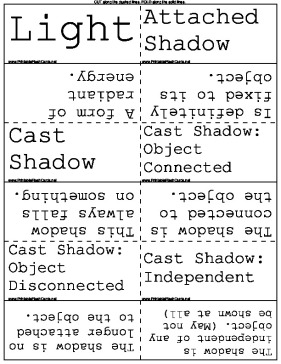

Great for TV and film creators, these entertainment flash cards cover media aesthetics
There are 39 flash cards in this set (7 pages to print.)
To use:
1. Print out the cards.
2. Cut along the dashed lines.
3. Fold along the solid lines.
Sample flash cards in this set:




| Questions | Answers |
|---|---|
| Light | A form of radiant energy. |
| Attached Shadow | Is definitely fixed to its object. |
| Cast Shadow | This shadow always falls on something. |
| Cast Shadow: Object Connected | The shadow is connected to the object. |
| Cast Shadow: Object Disconnected | The shadow is no longer attached to the object. |
| Cast Shadow: Independent | The shadow is independent of any object. (May not be shown at all) |
| Fast Falloff | The contrast of light and dark is severe. |
| Slow Falloff | The transition of light and shadow is gradual. |
| Elimination of falloff | The whole subject is lit up without any shadows. |
| High-key Lighting | The scene has an abundance of bright, usually slow falloff illumination and a light background. |
| Low-key Lighting | Selective, usually leaving the background and surrounding areas dark. |
| Above Eye-level | The eyes of the subject or the middle portion of the object. |
| Below Eye-level | The attached shadows reverse vertically and are exactly opposite their expected positions. |
| Predictive Lighting | A sign of a coming event using lighting techniques. |
| Dramatic Agent | An element that operates as an aesthetic intensifier in a scene. |
| Triangle Lighting | The triangular arrangement of key, back, and fill lights, with the back light opposite the camera and directly behind the object , and the key and fill lights on opposite sides of the camera and to the front and the side of the object. |
| Key Light | Principle source of illumination. |
| Back Light | Separates the figure from the background and provides sparkle. |
| Fill Light | Controls falloff. |
| Side Light | Comes from the side of the object, acting as an additional fill light and providing contour. |
| The Kicker | Comes from the back, is usually from below and off to one side. |
| Background Light | Illuminates the background, which can be the actual set of an interior or some kind of backdrop. |
| Chiaroscuro Lighting | Lighting for fast falloff and for light/dark contrast. (Exaggerated candle light) |
| Cameo Lighting | Illuminates the foreground figures while leaving the background totally dark. |
| Flat Lighting | Uses highly diffused light that seems to come from all directions. |
| Silhouette Lighting | The background is lit up not the figure. |
| Color | The property of light, not objects or liquids. |
| Color Perception | The object reflects parts of the light spectrum and absorbs the rest. The reflected light is focused by the lens of the eye onto the retina. |
| Hue | Hue describes the color itself. Red, blue, green, and yellow are hues. |
| High and Low Saturation | Saturation describes the color richness. |
| Brightness | The brightness of a color depends on how much light it reflects. Brightness is called lightness when it refers to how bright we perceive an object to be. |
| Additive Primary Colors | Red, green, and blue. |
| Subtractive Primary Colors | Cyan, Magenta, and yellow. |
| Additive Color Mixing | You can produce a great number of different hues. |
| Subtractive Color Mixing | They swallow one another's light until no light is passed. |
| High & Low-energy Color Distribution | Sets off a high-energy color against a low-energy background. |
| Color Distortion | With high-contrast lighting, it heightens its dramatic impact. |
| Saturation | The relative strength or purity of a color. |
| Achromatic | White, gray, and black. |